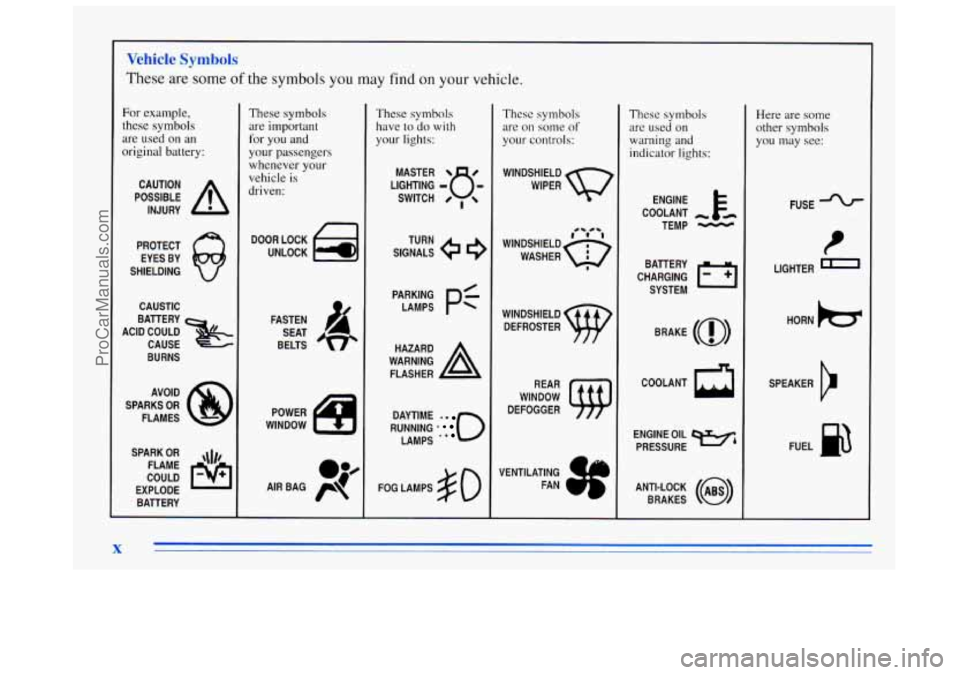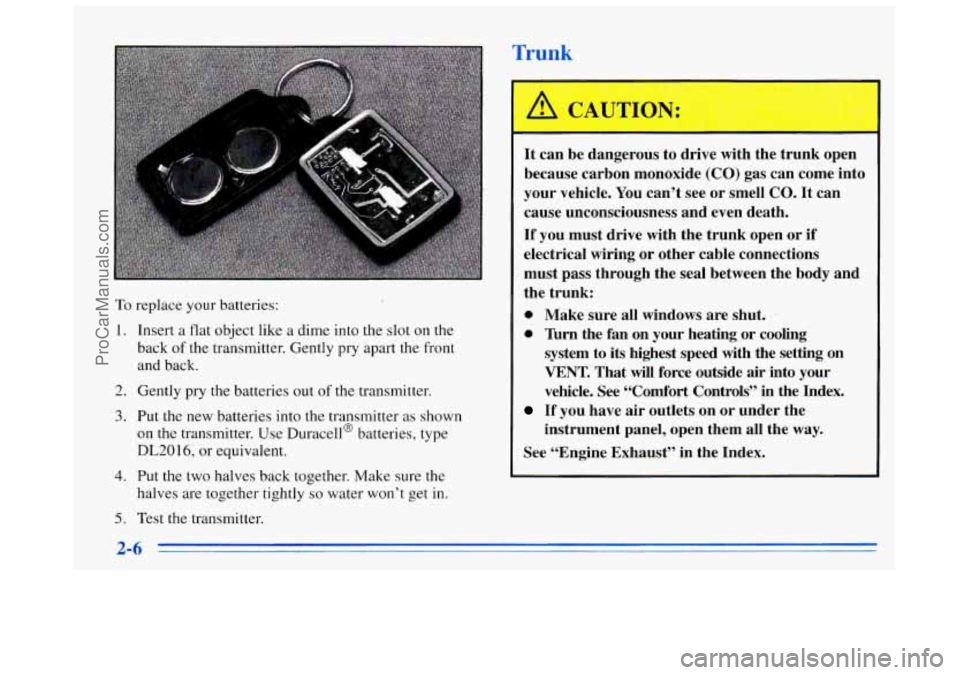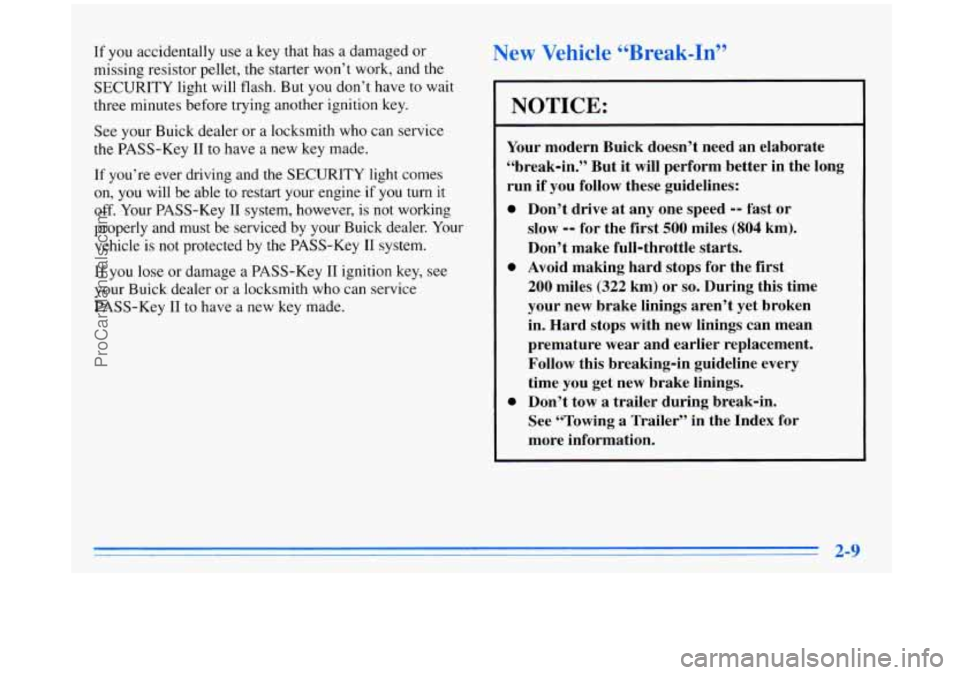1996 BUICK REGAL engine
[x] Cancel search: enginePage 3 of 356

The 1996 Buick Regal Owner’s Manual
7-
Seats and Restraint Systems ............................................................. 1-1
This section tells you how to use your seats and safety belts properly. It also explains “SRS” system.
This section explains how to start and operate your Buick.
This section tells you how to adjust the ventilation and comfort controls and how to operate your
audio system.
Here you’ll find helpful information and tips about the road and how to drive under different conditions.
This section tells you
what to do if you have a problem while driving, such as a flat tire or
overheated engine, etc.
Here the manual tells you how to keep
your Buick running properly and looking good.
This section tells
you when to perform vehicle maintenance and what fluids and lubricants to use.
This section tells you how to contact Buick for assistance and how to get service publications.
It also
gives you information on “Reporting Safety Defects” on page
8-7.
Index ........................................................................\
........ 9-1
Here’s an alphabetical listing of almost every subject in this manual. You can use it to quickly find something
you want to read.
Features and Controls .................................................................. 2-1
Comfort Controls and Audio Systems ..................................................... 3-1
YourDrivingandtheRoad .............................................................. 4-1
ProblemsontheRoad .................................................................. 5-1
Service and Appearance Care. ........................................................... 6-1
Maintenanceschedule .................................................................. 7-1
Customer Assistance Information ........................................................ 8-1
i
ProCarManuals.com
Page 6 of 356

Walter Marr and Thomas Buick
Buick’s chief engineer, Walter L. Marr (left), and
Thomas
D. Buick, son of founder David Dunbar Buick,
drove the first
Flint Buick in a successful Flint-Detroit
round trip
in July 1904.
David Buick was building gasoline engines by 1899,
and Man, his engineer, apparently built the first auto to
be called a Buick in
1900. However, Buick traditionally
dates its beginnings
to 1903. That was the year the
company was reorganized, refinanced and moved from
Detroit to Flint. Buick has always been a product
innovator. Buick engineers developed the William C. (Billy) Durant
ProCarManuals.com
Page 7 of 356

Durant also created a racing team that won 500 racing
trophies
in 1909 and 19 10, including successes at
Indianapolis two years before the
Tndy 500 began.
The success of Buick engines was visible not only on
the race track, but in endurance tests across the country
and around the world. Buick was the
only car to
complete
a 1,000-mile Chicago-to-New York race in
1906. And a Buick was the first car to travel across
South America, driven from Buenos Aires, Argentina,
over the Andes to Santiago, Chile in
1914.
I ,.:. .
1911 Model 21 Touring Car on BuickS Test Hill
Buick drew plenty of attention because it could climb
hills and run through mud like
no other car. Buick’s
endurance and reliability were world famous.
During World War
I, Buick built Liberty aircraft engines
as well as Red
Cross ambulances so successfully that
one Buick ambulance was awarded the Croix de Guerre
by the French government.
As a builder of premier automobiles, Buick was hard hit
by the Great Depression. However, new General
Manager Harlow
H. Curtice created popular new models
including the Special and the Roadmaster. Buick sales
soon flourished.
V
ProCarManuals.com
Page 8 of 356

In World War 11, Buick built aircraft engines, tanks and
other military hardware. This post-war period brought
great styling and engineering changes which resulted
in
increased sales. The torque converter automatic
transmission, Dynaflow, was introduced
in the 1948
Roadmaster. Buick’s Fdmous “portholes” came along
in 1949.
1949 Roadmaster
A high-compression V-8 engine was introduced in 1953.
And Buick’s famous vertical pillar “toothy” grille,
(introduced in 1942), became more massive
in the
post-war era.
~ 1.953 Skylark
Motor Trend magazine named the 1962 Buick Special
“Car of the Year.” The first production V-6 engine was
used in the Special.
ProCarManuals.com
Page 12 of 356

Ve hide bols
These are some of the symbols you may find on your vehicle.
For example,
these symbols
are used on an
original battery:
POSSIBLE A
CAUTION
INJURY
PROTECT EYES BY
SHIELDING
CAUSTIC
BURNS AVOID
SPARKS
OR
FLAMES
SPARK
OR ,\I/,
COULD FLAME
EXPLODE BATTERY
These symbols
are important
for you and
your passengers
whenever
your
vehicle is
driven:
DOOR LOCK
UNLOCK
FASTEN SEAT
BELTS
POWER
WINDOW
These symbols have to do
with
your lights:
SIGNALS e
TURN
RUNNING
* 0
DAYTIME ..
LAMPS .*
FOG LAMPS # 0
These symbols
are
on some of
your controls:
WINDSHIELD
WIPER
WINDSHIELD DEFROSTER
WINDOW
DEFOGGER
VENTILATING FAN
1 d J
These symbols
are used on
warning and
indicator lights:
ENGINE F-
COOLANT -
TEMP -
CHARGING I-1
BAllERY
SYSTEM
BRAKE
(a)
COOLANT a
ENGINE OIL e,
PRESSURE
ANTI-LOCK
(@)
BRAKES
Here are some
other symbols
you may see:
FUSE
t
LIGHTER n
HORN hs
SPEAKER
b
FUEL p3
ProCarManuals.com
Page 72 of 356

To replace your batteries:
1. Insert a flat object like a dime into the slot on the
back
of the transmitter. Gently pry apart the front
and back.
2. Gently pry the batteries out of the transmitter.
3. Put the new batteries into the transmitter as shown
on the transmitter. Use Duracell@ batteries, type
DL20 16, or equivalent.
4. Put the two halves back together. Make sure the
halves are together tightly
so water won’t get in.
5. Test the transmitter.
I
It can be dangerous to drive with the trunk open
because carbon monoxide (CO) gas can come into
your vehicle. You can’t see or smell
CO. It can
cause unconsciousness and even death.
If you must drive with the trunk open or if
electrical wiring
or other cable connections
must pass through the seal between the body
and
the trunk:
0 Make sure all windows are shut.
0 lbrn the fan on your heating or cooling
system to its highest speed with the setting on
VENT. That will force outside air into your
vehicle. See “Comfort Controls”
in the Index.
instrument panel, open them all the
way.
If you have air outlets on or under the
See “Engine Exhaust” in the Index.
ProCarManuals.com
Page 74 of 356

Parking Lots
If you park in a lot where someone will be watching
your vehicle, it’s best to lock it up and take your keys.
But what if you have to leave your ignition key? What if
you have to leave something valuable in your vehicle?
0 Put your valuables in a storage area, like your trunk
Lock the glove box.
Lock all the doors except the driver’s.
Then take the door key with you.
or glove
box.
Your vehicle
is equipped
with
the PASS-Key I1
(Personalized Automotive
Security System)
theft-deterrent system.
PASS-Key I1 is a passive
theft-deterrent system. It
works when you insert or
remove
the key from the
ignition. PASS-Key
I1 uses a resistor pellet
in the ignition key
that matches
a decoder in your vehicle.
When the PASS-Key I1 system senses that someone is
using the wrong key, it shuts down the vehicle’s starter
and fuel systems.
For about three minutes, the starter
won’t work and
fuel won’t go to the engine. If someone
tries to start your vehicle again or uses another key
during this time, the vehicle will not start. This
discourages someone from randomly trying different
keys
with different resistor pellets in an attempt to make
a match.
The ignition
key must be clean and dry before it’s
inserted in the ignition or the engine may not start.
If the
engine does not start and the SECURITY light is on, the
key may be dirty or wet. Turn
the ignition off.
Clean and dry the key. Wait about three minutes and try
again. The SECURITY light may remain on during this
time. If
the starter still won’t work, and the key appears
to be clean and dry, wait about three minutes and try
another ignition key. At this time, you may also want to
check the fuse (see
“Fuses and Circuit Breakers” in the
Index). If the starter won’t work with the other key, your
vehicle needs service.
If your vehicle does start, the first
ignition key may be faulty. See your Buick dealer or
a
locksmith who can service the PASS-Key 11.
2-8
ProCarManuals.com
Page 75 of 356

If you accidentally use a key that has a damaged or
missing resistor pellet, the starter won’t work, and the
SECURITY light will flash. But you don’t have to wait
three minutes before trying another ignition key.
See your Buick dealer
or a locksmith who can service
the PASS-Key
I1 to have a new key made.
If you’re ever driving and the SECURITY light comes
on, you will be able to restart your engine if you turn it
off. Your PASS-Key I1 system, howevcr, is not working
properly and must be serviced by your Buick dealer. Your
vehicle is not protected by the PASS-Key I1 system.
If you lose or damage a PASS-Key I1 ignition key, see
your Buick dealer or a locksmith who can service
PASS-Key I1 to have a new key made.
New Vehicle CCBreak-InSS
NOTICE:
Your modern Buick doesn’t need an elaborate
“break-in.” But it will perform better in the long
run if you follow these guidelines:
0 Don’t drive at any one speed -- fast or
slow -- for the first 500 miles (804 km).
Don’t make full-throttle starts.
200 miles (322 km) or so. During this time
your new brake linings aren’t yet broken
in. Hard stops with new linings can mean
premature wear and earlier replacement.
Follow this breaking-in guideline every
time you get new brake linings.
See “Towing
a Trailer’’ in the Index for
more information.
0 Avoid making hard stops for the first
0 Don’t tow a trailer during break-in.
ProCarManuals.com